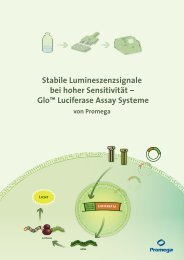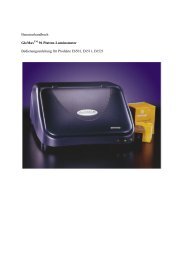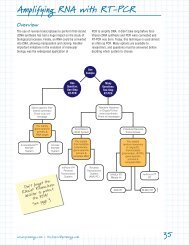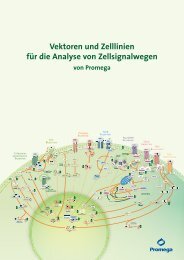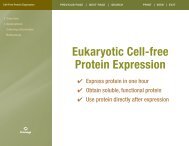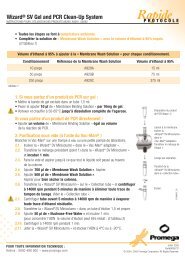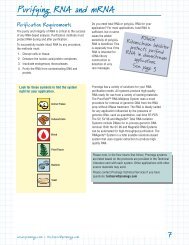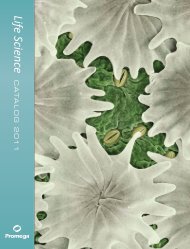2013 Promega catalogue
2013 Promega catalogue
2013 Promega catalogue
You also want an ePaper? Increase the reach of your titles
YUMPU automatically turns print PDFs into web optimized ePapers that Google loves.
Life<br />
Science<br />
Catalog<br />
<strong>2013</strong><br />
Worldwide Contact List<br />
Cell Signaling<br />
HaloTag ® Ligand Building Blocks<br />
Product Size Cat.# Price ($)<br />
HaloTag ® Amine (O4) Ligand 5 mg P6741 928<br />
HaloTag ® Amine (O2) Ligand 5 mg P6711 928<br />
HaloTag ® Iodoacetamide (O4) Ligand 5 mg P6771 923<br />
HaloTag ® Iodoacetamide (O2) Ligand 5 mg P1681 923<br />
HaloTag ® Succinimidyl Ester (O4) Ligand 5 mg P6751 923<br />
HaloTag ® Succinimidyl Ester (O2) Ligand 5 mg P1691 923<br />
HaloTag ® Thiol (O4) Ligand 5 mg P6761 923<br />
For Research Use Only. Not for Use in Diagnostic Procedures.<br />
Description: The HaloTag ® Ligand Building Blocks can carry a variety of<br />
functionalities, including fluorescent labels, affinity tags and attachments to<br />
a solid phase. The covalent bond forms rapidly under general physiological<br />
conditions, is highly specific and essentially irreversible. The HaloTag ® Ligand<br />
Building Blocks allow researchers to apply the chloroalkane group that<br />
HaloTag ® protein reacts with to any compound or surface with a compatible<br />
chemical group, creating endless possible applications.<br />
The HaloTag ® Succinimidyl Ester (04) Ligand contains a reactive succinimidyl<br />
ester (SE) group connected to an alkyl chloride separated by three ethylene<br />
glycol repeats (04). The HaloTag ® Succinimidyl Ester (04) Ligand can be<br />
successfully conjugated to any reporter group, protein, or nucleic acid<br />
derivative containing an amine, forming stable amide bond linkages. The<br />
ligand with functional group can then be used with the HaloTag ® protein for<br />
any application of interest.<br />
The HaloTag ® Succinimidyl Ester (O2) Ligand contains a reactive succinimidyl<br />
ester (SE) group connected to an alkylchloride separated by an ethylene glycol<br />
repeat (O2). The HaloTag ® Succinimidyl Ester (O2) Ligand can be successfully<br />
conjugated to any reporter group, protein, or nucleic acid derivative containing<br />
an amine, forming stable amide bond linkages. The ligand with functional group<br />
can then be used with the HaloTag ® protein for any application of interest.<br />
The HaloTag ® Amine (04) Ligand contains a reactive amine group<br />
connected to an alkyl chloride, separated by an ethylene glycol repeat (04).<br />
The HaloTag ® Amine (04) Ligand can be successfully conjugated to any<br />
reporter group, protein, or nucleic acid derivative containing an activated<br />
carboxylic acid, sulfonyl halide or isocyanate. Examples of activated carboxylic<br />
acids are succinimidyl esters, STP esters, acid halides, and TFP esters. The<br />
ligand with functional group can then be used with the HaloTag ® protein for<br />
any application of interest.<br />
The HaloTag ® Amine (O2) Ligand contains a reactive amine group<br />
connected to an alkylchloride, separated by an ethylene glycol repeat (O2).<br />
The HaloTag ® Amine (O2) Ligand can be successfully conjugated to any<br />
reporter group, protein, or nucleic acid derivative containing an activated<br />
carboxylic acid, sulfonyl halide, or isocyanate. Examples of activated carboxylic<br />
acids are succinimidyl esters, STP esters, acid halides, and TFP esters. The<br />
ligand with functional group can then be used with the HaloTag ® protein for<br />
any application of interest.<br />
The HaloTag ® Iodoacetamide (04) Ligand contains a reactive iodoacetamide<br />
group connected an alkyl chloride separated by an ethylene glycol repeat (04).<br />
The HaloTag ® Iodoacetamide (04) Ligand has been designed to rapidly react<br />
with sulfhydryl-containing molecules, whether small organic compounds,<br />
peptides or proteins. The ligand with functional group can then be used with<br />
the HaloTag ® protein for any application of interest.<br />
The HaloTag ® Iodoacetamide (O2) Ligand contains a reactive iodoacetamide<br />
group connected to an alkylchloride separated by an ethylene glycol repeat<br />
(O2). HaloTag ® Iodoacetamide (O2) Ligand has been designed to rapidly react<br />
with sulfhydryl-containing molecules, whether small organic compounds,<br />
peptides or proteins. The ligand with functional group can then be used with<br />
the HaloTag ® protein for any application of interest.<br />
The HaloTag ® Thiol (O4) Ligand contains a reactive sulfhydryl group connected<br />
to an alkyl chloride separated by three ethylene glycol repeats (04). The<br />
HaloTag ® Thiol (04) Ligand can be successfully conjugated to any reporter<br />
group, cross-linking reagent (bound or free), or nucleic acid derivative<br />
containing a number of different alkylating groups, forming stable thioether<br />
bonds. Commonly used reagents that rapidly react with sulfhydryls include<br />
iodo- or bromo-acetyls or benzyls, bromo- or chloro-mustards, maleimides,<br />
aziridines, acryloyl derivatives, and halide or sulfonate containing arenes (those<br />
bearing Electron Withdrawing Groups (EWGs) react most rapidly). The reactive<br />
ligand can be captured with HaloTag ® protein either before or after the thiol<br />
group is functionalized for any application of interest.<br />
Storage Conditions: Store Cat.# P1691 and P6751 at or below –70°C<br />
under inert atmosphere. Store Cat.# P6711 and P6741 at or below –20°C in<br />
an air-tight container in the absence of light. Store Cat.# P1681, P6771 and<br />
P6761 at or below –20°C under inert atmosphere in the absence of light. See<br />
<strong>Promega</strong> Product Information for additional details on individual products.<br />
Section<br />
Contents<br />
Table of<br />
Contents<br />
272<br />
For complete and up-to-date product information visit: www.promega.com/catalog





